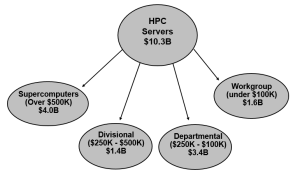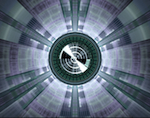This morning at SC14 during their annual breakfast briefing on high performance computing market trends, global analyst firm IDC kicked off with a correction to one of their more robust predictions. Over the last couple of years, the group projected that supercomputing would hit a growth stage around the 2014 timeframe. As many are aware, the market has actually turned out to be something of a purgatory—with major technology shifts in processor, memory, accelerator, and storage still off on the horizon.
While major announcements, including the undisputed top story for SC14 around the CORAL procurement, are providing a glimpse of what is yet to come in terms of architectural and system purchase trends at the highest end, the rest of the market has ground to a halt. The question is, to what extent will the new wave of machines that are driven by the realization of these trends influence actual growth?
Before we get to those projections, it’s worth noting the reasons for the standstill in supercomputing market momentum. And even before that, it’s probably no coincidence that this isn’t the first time we’ve used the word “standstill” this week. The global Top 500 list of the world’s fastest supercomputers remained almost entirely unchanged at the high end (the top 100 systems) with only predictable alterations in the lower ranking machine class.
But again—is this something to worry about for the long term? IDC doesn’t appear to believe so. And in fact, they pointed to a few solid reasons for why the unexpected stagnation came about in the first place. First, as was evidenced by that Top 500 standstill (even if the installations haven’t caught up with the funding) there was a definite slowdown worldwide at the top of the supercomputing spectrum. Second, the IBM and Lenovo deal put several contracts on extended hold over the last several months.
 The last reason is less of an explanation as an indicator of something more profound, and probably less situational. 2013 spending was down by $800 million (in the context of an overall $10.3 billion market). While IDC didn’t delve into the larger elements that may influence the drop off, and of course the problems cited above don’t help matters, there is hope on the horizon.
The last reason is less of an explanation as an indicator of something more profound, and probably less situational. 2013 spending was down by $800 million (in the context of an overall $10.3 billion market). While IDC didn’t delve into the larger elements that may influence the drop off, and of course the problems cited above don’t help matters, there is hope on the horizon.
This optimism is rooted in realities that we see coming down the pike over the next couple of years. While IDC didn’t cite these, it’s clear that having a strong return of IBM’s supercomputing might into the market is set to shake things up, as evidenced by CORAL and the OpenPower GPU machines that are set to do far more in much less space. Second, the processor innovations from Intel, including Knights Landing and as we just learned of this week, Knights Hill are certain to push other centers to hold their cards to see what to play next if their missions allow. New memory technologies from Micron and even more theoretically, the Memristor, phase change, spin-torque and other memory wonders are also on the horizon—as are new generations of GPUs from NVIDIA which will send performance per watt through the roof, beginning with the upcoming K80. Storage vendors, who have a beautiful opportunity to rise up to meet the wave of simulation data in HPC, are also pushing forward with burst buffer, SSD, and other technology ready to snap into hyper-accelerated, memory-laden, ultra-efficient machines. And let’s not forget about the emerging ARM ecosystem, the long-running underdog for HPC until its 64 bit future and support plans rolled over the course of the year.
The point is, when you look at the stagnant Top 500 list or read through the flat numbers for the market as it stands, read the paragraph above. Because, if nothing else, it will make you feel better.
Let’s move out for a moment and take a look at a few key slides that highlight some of these points. First, we have the historical spending paradigm from the dawn of time until 2012. Mentally slice in the new figure at just a tick over $10 billion for a sense of the choppiness of the market as of late, keeping in mind that the large spike in market growth for the supercomputer segment (which is all this chart represents) was the result of a few massive deals versus a broad industry trend.
And so if all of this wasn’t convoluted enough in 2014, there’s another emerging problem—albeit an esoteric one. Simply put, it’s because of data, or, more specifically, factoring the exploding market around this into the broader HPC spreadsheet. It’s increasingly difficult for vendors in particular to draw lines between their “big data” and HPC businesses since so many procurements are trending around analytics. While IDC has segmented high performance data analysis as its own segment in the HPC market, one has to wonder at what point that model will break. Consider, for instance, users with standard cluster fare running message passing-intensive workloads like NASA and their climate modeling efforts. As we wrote yesterday, even with the new SGI system they purchased for this compute and data-intensive workload, they’re still devoting a great deal of their operations to data management and handling. This is not to mention others with large scale simulations that are throwing off more data than ever before and are finding themselves allocating an increasing amount of their cores towards just dealing with such data.
On that note, storage is the fastest growing segment under the HPC umbrella. The storage market was $4.1 billion in 2012, which IDC predicts will grow to $6 billion by 2017, representing over 8% CAGR. To put that in some context, recall that in 2000, the entire HPC server market from IDC figures was $6 billion. The HPDA momentum to drive this and further, with great storage comes the need for stronger interconnects, which will be another hot growth area.
As Steve Conway of IDC noted this morning, his group is having a harder time trusting in the numbers they’re given by the vendors. Not necessarily because of any padding, but because the differentiation is difficult. What is high performance data analysis, what is HPC? Where is the cutoff? Interestingly, it was obvious that for the first time, their language was reshaped, perhaps around the problem. Instead of seeing a lot of data around HPC, the two classifications were simply HPDA and supercomputing. Those two terms draw much clearer lines around the market segmentation than just calling it all HPC and assuming that the data volume and management troubles are part and parcel.
But consider these figures…67% of the HPC sites IDC surveys are using HPDA in some form in their workflows. But the real indicator is that this is consuming 30% of their compute cycles. Accordingly, in their diverged line for the server market at the high end, HPDA servers will comprise $1.2 billion. and the storage segment of HPDA will $800 million.
But back to the troublesome part of all of this—at what point do these stop being separate areas? When do HPC and HPDA diverge and if IDC chooses not to take this route, how do they continue looking at them through the same lens? It’s a tricky problem—one that we’ve encountered here as we try to partition stories across Datanami, EnterpriseTech, and HPCwire. It used to be clear what fit where, but now, it’s all big data. It’s all infrastructure. And if we take a positive tack, it’s all more interesting when it’s not easy to tell.





























































